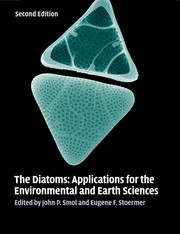Book contents
- Frontmatter
- Contents
- List of contributors
- Preface
- Part I Introduction
- Part II Diatoms as indicators of environmental change in flowing waters and lakes
- Part III Diatoms as indicators in Arctic, Antarctic, and alpine lacustrine environments
- Part IV Diatoms as indicators in marine and estuarine environments
- 15 Diatoms and environmental change in large brackish-water ecosystems
- 16 Applied diatom studies in estuaries and shallow coastal environments
- 17 Estuarine paleoenvironmental reconstructions using diatoms
- 18 Diatoms on coral reefs and in tropical marine lakes
- 19 Diatoms as indicators of former sea levels, earthquakes, tsunamis, and hurricanes
- 20 Marine diatoms as indicators of modern changes in oceanographic conditions
- 21 Holocene marine diatom records of environmental change
- 22 Diatoms as indicators of paleoceanographic events
- 23 Reconsidering the meaning of biogenic silica accumulation rates in the glacial Southern Ocean
- Part V Other applications
- Part VI Conclusions
- Glossary, acronyms, and abbreviations
- Index
- References
21 - Holocene marine diatom records of environmental change
from Part IV - Diatoms as indicators in marine and estuarine environments
Published online by Cambridge University Press: 05 June 2012
- Frontmatter
- Contents
- List of contributors
- Preface
- Part I Introduction
- Part II Diatoms as indicators of environmental change in flowing waters and lakes
- Part III Diatoms as indicators in Arctic, Antarctic, and alpine lacustrine environments
- Part IV Diatoms as indicators in marine and estuarine environments
- 15 Diatoms and environmental change in large brackish-water ecosystems
- 16 Applied diatom studies in estuaries and shallow coastal environments
- 17 Estuarine paleoenvironmental reconstructions using diatoms
- 18 Diatoms on coral reefs and in tropical marine lakes
- 19 Diatoms as indicators of former sea levels, earthquakes, tsunamis, and hurricanes
- 20 Marine diatoms as indicators of modern changes in oceanographic conditions
- 21 Holocene marine diatom records of environmental change
- 22 Diatoms as indicators of paleoceanographic events
- 23 Reconsidering the meaning of biogenic silica accumulation rates in the glacial Southern Ocean
- Part V Other applications
- Part VI Conclusions
- Glossary, acronyms, and abbreviations
- Index
- References
Summary
Introduction
Atmospheric temperature records from central Greenland and Antarctic ice cores reveal a dramatic shift between the Late Pleistocene and the Holocene in terms of estimates and amplitudes of temperature change. Following recovery of these long, high-resolution ice cores in the early 1990s, initially it was believed that this shift into the Holocene involved a change from low mean temperatures with large, rapid oscillations on decadal to millennial timescales, to high mean temperatures with relatively little variability. More recently, other records from different regions of the world, together with our increased understanding of external climate forcings and feedbacks, have shown that this ice-core-derived picture of Holocene climate stability is not the case (Maslin et al., 2001; Wanner et al., 2008). Holocene climate variability appears to exhibit relatively regular patterns of change. However, these patterns of change are complex; not all changes are observed globally or synchronously (Mayewski et al., 2004). And, although the oscillations in climate during the Holocene are of lower amplitudes than those of the Late Pleistocene, they are of sufficient magnitude to cause significant perturbations to our contemporary climate and to have had an impact on human civilizations.
The primary goal of this chapter is to present a detailed view of the contribution of diatom analysis from marine sedimentary records to our understanding of climatic and environmental change during the Holocene. This chapter will provide a link between other chapters in this book that deal with diatoms as indicators of recent changes in oceanographic condition (Romero and Armand, this volume) and diatoms as indicators of paleoceanographic events (Jordan and Stickley, this volume).
- Type
- Chapter
- Information
- The DiatomsApplications for the Environmental and Earth Sciences, pp. 401 - 423Publisher: Cambridge University PressPrint publication year: 2010
References
- 3
- Cited by

